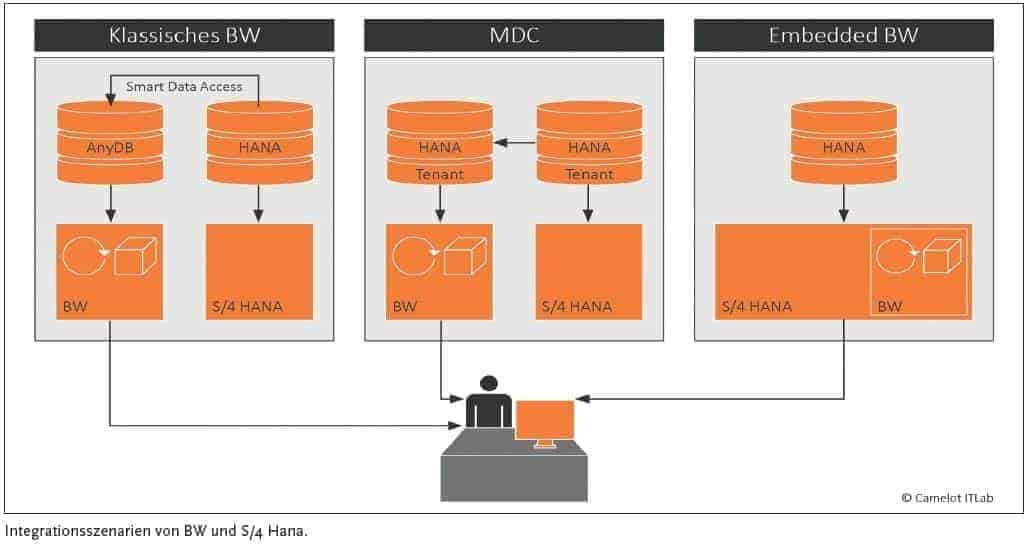SAP BW - a relic from the past?
![[shutterstock.com:574721830, Aha-Soft]](https://e3mag.com/wp-content/uploads/2017/02/shutterstock_574721830.jpg)

As early as 2009, one year before the first release of Hana, SAP co-founder Hasso Plattner published the seminal white paper "A Common Database Approach for OLTP and OLAP Using an In-Memory Column Database".
In it, he challenges the separation of OLTP and OLAP applications that has been practiced for many years. His theory is that a column-based database operating exclusively in memory could be used by both transactional and analytical applications simultaneously.
When SAP Hana was announced in 2010, this unification was logically a defined goal on every SAP Hana roadmap. At the same time, SAP is pushing the analysis of data directly on the transactional systems (the so-called Operational Reporting).
With Operational Reporting, SAP has created the possibility to evaluate data without having to transfer it to a BW system beforehand. This relieves the BW system and creates the possibility to perform real-time analyses.
For this purpose, Hana Live is available to every Business Suite on Hana customer free of charge, which enables Hana-optimized operational reporting in the Business Suite.
Hana Live is a combination of a virtual data model based on SAP standard tables and a user interface for its evaluation.
S/4 Hana also contains a corresponding solution, albeit with a different technical underpinning. Unlike in Hana Live, the virtual data model of Embedded Analytics is not based on the database level, but is created and managed on the application server.
This eliminates the need for time-consuming double maintenance of authorizations in the database and application server. But even if an S/4 Hana system increasingly combines the functionalities of formerly separate modules, embedded analytics alone will not be able to meet a company's reporting requirements in the foreseeable future.
A data warehouse is missing, which integrates and harmonizes data from other systems. A BW is therefore still needed.
BW and S/4
A system landscape with S/4 Hana and SAP BW can be set up in different ways.
The individual variants differ in particular in the extraction of data into BW and in the administration effort.
The following three scenarios are possible.
1: Classic approach: BW and S/4
As before, a BW system can be operated completely separately in an S/4 landscape.
The introduction of an S/4 Hana system nevertheless requires extensive changes in modeling: S/4 Hana currently does not yet have the extractors for BW known from the Business Suite (status: S/4 Hana 1511).
Instead, direct access to the tables at database level is necessary. This can be achieved by regularly synchronizing the data between S/4 Hana and the BW database. However, this procedure is time-consuming and often leads to outdated data in BW.
If a BW-on-Hana system is used, the Hana Smart Data Access (SDA) functionality can be used instead.
SDA supports access to different databases, but also to other Hana instances. For this purpose, a virtual table is created that forwards read and write accesses to the target database without persistence.
In BW, virtual tables can be reused, for example, through Open ODS Views.
2: Operation on shared database: MDC
Another option is to use separate application servers using the same database in a multitenant database container (MDC) scenario.
Since Service Pack Stack 09, Hana has been able to operate multiple client databases (tenants). This means that parallel operation of several SAP applications on the same database instance is now officially supported.
Detailed information on this scenario can be found in SAP Note 2096000. A whitelist of further applications that can be combined by MDC can be found in SAP Note 1661202.
Even when using the MDC concept, it is necessary to transfer data from S/4 Hana and BW at database level. For this, SAP recommends the use of the already explained Hana SDA (Smart Data Access).
Here, however, unnecessary effort must be expended for data transfer, since SDA is designed to communicate with different databases on other servers.
So instead of reading all the other tenant's data within the Hana instance, SDA establishes a new database connection and transfers the data across the operating system's network stack.
However, since a multitenant Hana database certainly supports data transfer directly between the individual tenants, it is likely that SAP will deliver native functionality for integrating data from other Hana tenants into BW here in one of its future releases.
In both cases, extracting data from S/4 Hana is faster than in a classic system landscape because network communication between multiple servers is eliminated.
3: Shared operation: Embedded BW
As in the Business Suite since NetWeaver version 7, an "embedded BW" is included in S/4 Hana. This contains the same transactions and functions as a separate BW, but runs on the same application server.
Usually, it is used on a separate client. However, SAP currently recommends using embedded BW exclusively for operational reporting.
Nevertheless, it is possible to integrate and process data from external systems as in a classic BW.
Using an embedded BW for enterprise-wide reporting is an uncommon scenario to date, as it presents new challenges in the area of administration and system utilization.
While Hana has been specifically designed for parallel operation of multiple applications at least since the introduction of the MDC concept, there is still little experience of how the hardware of an application server would have to be dimensioned to execute both analytical and transactional processes.
In addition, the maximum size of an S/4 Hana system is limited because scale-out scenarios, i.e., the expansion of the database size through additional servers, have not yet been released for S/4 Hana.
It should also be noted that an update of the NetWeaver or the database always affects both components. As a result, the downtime as well as the effort for preparatory and follow-up work increases.
The integrated BW is already used by the S/4 Hana standard. Here, among other things, reporting on Hana Views is enabled, which are used in particular in the financial area of S/4 Hana.
Conclusion:
For enterprise-wide reporting across multiple systems, a BW system is still necessary even with S/4 Hana.
When migrating from an existing SAP Business Suite installation, it is important to note that the extraction of data into BW changes fundamentally.
Since S/4 Hana does not currently provide extractors for SAP BW, data must be transferred at database level. The use of embedded BW therefore appears to be an interesting solution for S/4 Hana customers.
However, the scenario significantly complicates the administration of the shared application server. Furthermore, the maximum size of an S/4 Hana installation is, as of today, still limited.
If one implements an MDC scenario, the elimination of data transfer over the network increases the speed of extraction into the BW, but still lacks native functionality for data transfer between Hana tenants in the BW.
In contrast to the application, these are administered together and thus make the operation of this variant more complicated, which nevertheless represents a sensible compromise from the other two solutions.
It remains to be seen how SAP will further develop these scenarios in the future and whether customers will increasingly rely on operational reporting and thus on embedded BW for enterprise-wide reporting.
(Read also the article "The BW Quarter Roadmap in the Scene section, on page 10).







